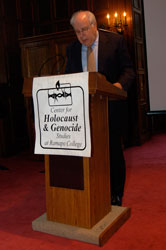- About Ramapo
- Academics
- Admissions & Aid
- Student Life
- Athletics
- Alumni
- Arts & Community
- Quick Links
- Apply
- Visit
- Give
Michael Nevins Discusses Eminent Physician Art and Medicine in the Theresienstadt Ghetto/Concentration Camp
(PDF) (DOC) (JPG)December 3, 2009
 MAHWAH – Dr. Michael Nevins, a respected physician and historian of medicine, spoke at Ramapo College of New Jersey on December 3 under the auspices of the Center for Holocaust and Genocide Studies as well as the Ramapo College History and Pre-med Clubs.
MAHWAH – Dr. Michael Nevins, a respected physician and historian of medicine, spoke at Ramapo College of New Jersey on December 3 under the auspices of the Center for Holocaust and Genocide Studies as well as the Ramapo College History and Pre-med Clubs.
As Dr. Nevins described, Terezin (or Theriesenstadt), located 40 miles northwest of Prague in today’s Czech Republic, was originally a military installation dating back to 1780, but transformed under the Nazis first into an overflow Gestapo prison and then later to an assemblage camp where Jews were concentrated for varying periods until they were deported to the death camps of the East. The Nazi SS also used it a “model camp,” both to hone the administration of their “kingdom of death” and to show to international visitors how supposedly well the Jews were being treated.
Nonetheless, as Dr. Nevins pointed out, between November 1941 and May 1945 of nearly 160,000 people sent there, some 36,000 died of illness or starvation; the rest, about 88,000, were deported to extermination or work camps with only a few thousand of these surviving the ordeal. When the Russians liberated Terezin in May 1945, there were only about 30,000 survivors, more dead than alive. Within weeks many more died of a typhus epidemic. Of more than 12,000 children who passed through Terezin, only 325 survived.
In showing their sketches and watercolors, Dr. Nevins showed how some of the imprisoned physicians and artists strove to record the truly harsh environment of the camp. He made it clear that their artwork and efforts to heal the sick served not to preserve a bit of their experience for posterity, but as importantly also constituted a form of resistance to the daily regimen of humiliation and inhumanity inflicted by their Nazi tormentors.
Dr. Michael Nevins, was raised in New York City and practiced internal medicine/cardiology for four decades in northern New Jersey. He has written several books about aspects of medical history, especially Jewish medical history, most recently “Jewish Medicine: What it is and Why it Matters” and “A Tale of Two “Villages”: Vineland and Skillman, NJ.”
E-News Archives
| 2023 | 2022 | 2021 | 2019 | 2018 | 2017 | 2016 | 2015 | 2014 | 2013 | 2012 | 2011 | 2010 | 2009 | 2008 | 2007 |Copyright ©2025 Ramapo College Of New Jersey. Statements And Policies. Contact Webmaster.

Follow Us!